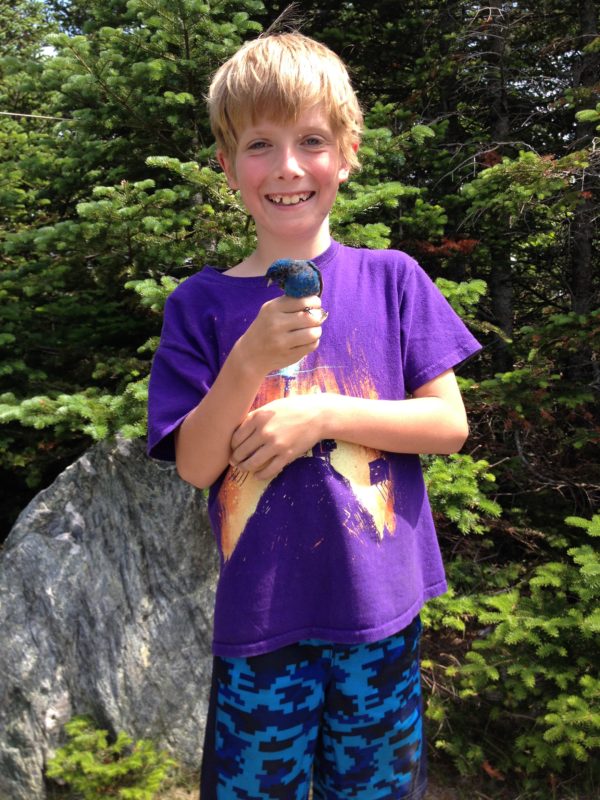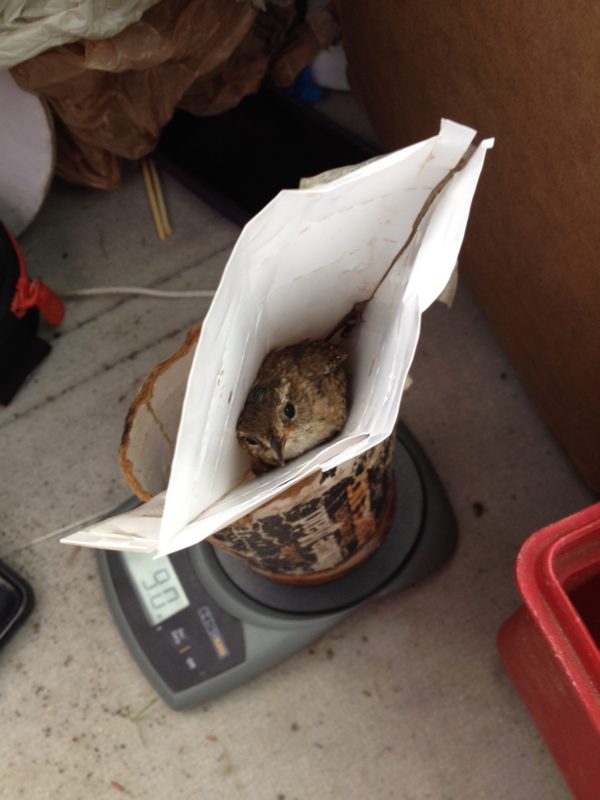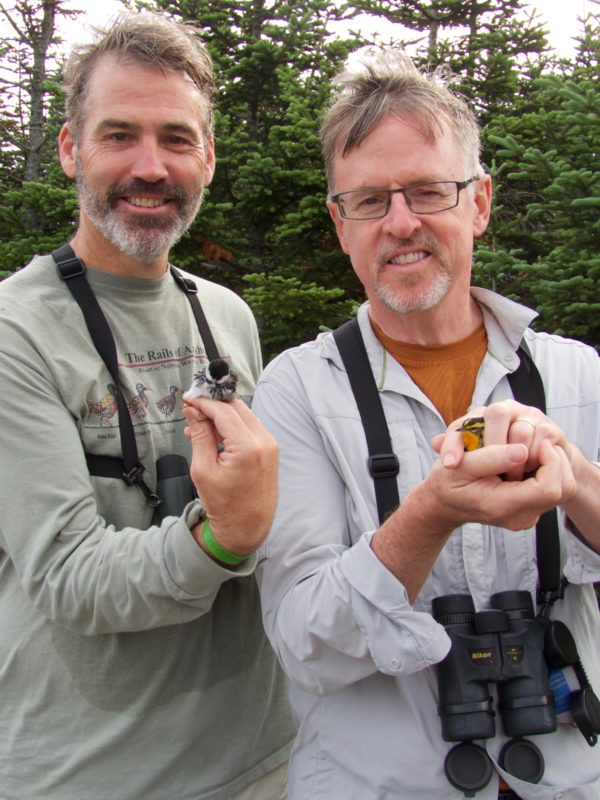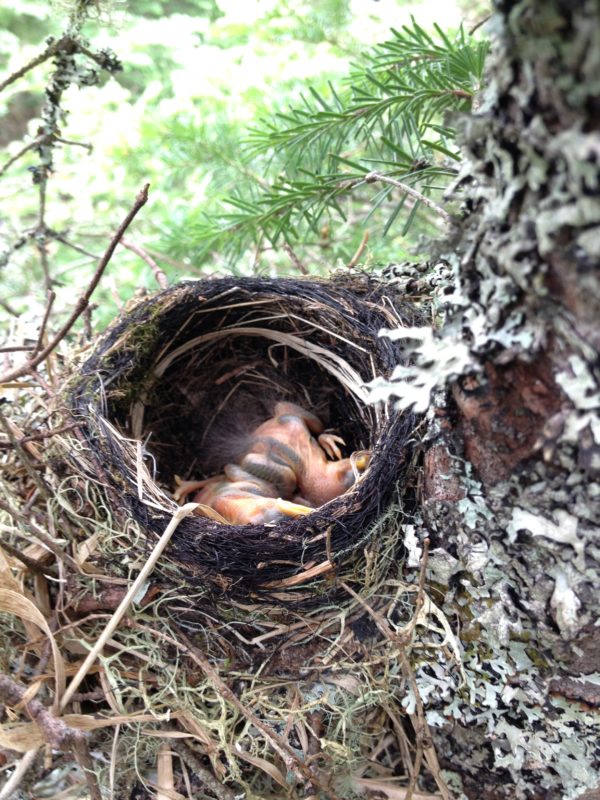
Future ornithologist Quinn Collins with VCE’s first-ever mist-netted Indigo Bunting at 3900 feet elevation on the Mt. Mansfield ridgeline, 7 July 2016. Photo by C. Rimmer.
On 6-7 July, VCE completed week 7 of our annual avian monitoring on the Mansfield ridgeline. Brendan Collins, Susan Hindinger and I arrived on Wednesday evening to conditions that could not have been more benign: temperatures in the mid-60sF and not a breath of wind. We set 26 nets and immediately began catching birds, ending up with 25 individuals by nightfall. Vocal activity was more pronounced than it has been in the past 2-3 weeks, typical at this stage of the breeding season, when most pairs have nestlings or fledglings.

A Winter Wren casts a baleful eye from the VCE weighing cone (registering all of its 9.0 grams) on Mt. Mansfield, 7 July 2016. Photo by Susan Hindinger.
Clouds moved in overnight, and winds picked up from the southwest, but temperatures remained relatively balmy (it’s a rare visit when nothing more than a t-shirt is needed…). Netting activity was steady through midday, and we ended up with 60 captures overall, including a couple of surprises. The hands-down winner on that front was a yearling male Indigo Bunting, the first we have recorded on the ridgeline in 25 years, including 3 seasons of fall migration banding in 1995-97. Other non-local adult captures included a female Hairy Woodpecker, a striking female Blackburnian Warbler, and a yearling male Ovenbird. We also netted the season’s first fledgling, a bob-tailed White-throated Sparrow.

VCE Board member Jared Keyes (left) with a mist-netted male Blackpoll Warbler and friend Phil Edmundson (right) with an adult female Blackburnian Warbler, Mt. Mansfield, 7 July 2016. Photo by Susan Hindinger.
An interesting, but not unexpected, find was an active Swainson’s Thrush nest with two chicks 3-4 days old, just below the uppermost parking lot at 3900′ elevation. This is the highest elevation nest we have ever found, and may be the highest so far recorded in VT. Only in the past 3-5 years have we documented his species as a regular inhabitant on the ridgeline, and it now rivals Bicknell’s Thrush in abundance, with several pairs clearly nesting in our study area (based on incubation/brood patches of mist-netted females).
Our netting totals:
Hairy Woodpecker 1 female in well-advanced primary molt
Red-breasted Nuthatch 3 free-flying birds in juvenal plumage
Winter Wren 1 adult male
Bicknell’s Thrush 9 (3 new yearling males, 2 returns from previous years, 4 within-season recaptures)
Swainson’s Thrush 9 (1 new male and female, 1 male banded in 2014, 6 within-season recaptures)
American Robin 3 previously unbanded adults (1 male, 2 females)
Ovenbird 1 yearling male
Blackburnian Warbler 1yearling female
Blackpoll Warbler 10 (2 new yearling males, 2 new females [one in early primary molt], 3 males from previous years, 3 within-season recaptures)
Yellow-rumped Warbler (Myrtle) 11 (5 new males [4 yearlings], 1 return male, 6 within-season captures)
Dark-eyed Junco (Slate-colored) 4 adult males (3 new, 1 banded in 2015)
White-throated Sparrow 8 (4 new adult males, 3 within-season adult recaptures, 1 fledgling)
Indigo Bunting 1 yearling male

A Swainson’s Thrush nest with two 3-4 day-old chicks, the highest-elevation nest ever recorded of this species on Mt. Mansfield, and reflecting its steady upslope movement into montane forests. Photo by C. Rimmer.
With only three weeks to go before our summer field season concludes, we expect a dramatic increase in numbers of fledglings and molting adults during our remaining weekly visits. As in the past three years, red squirrels are all but absent on the ridgeline, and the current fir-spruce cone crop is minimal, so we expect another productive nesting season for mountaintop birds. Stay tuned.

How exciting! We had a handsome adult male Indigo Bunting at Birdcraft this year. It’s funny to me how you have White throated Sparrows, and we say goodbye to them for the summer, catching tons in the fall.
We get only the occasional Blackpoll warbler so it’s always a thrill.
We hardly ever catch Blacburnian warblers :+(
Very fun to read your numbers and species, and I hope to get up in August.
Best,
Judy
So sad!